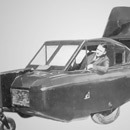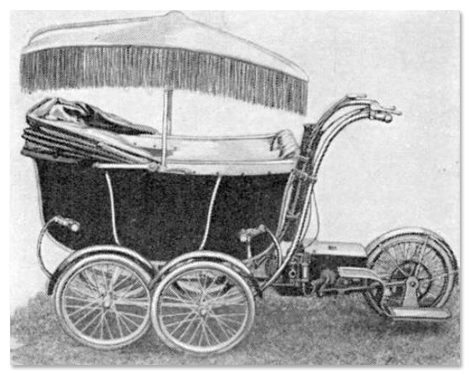The 12 Most Ridiculous Old-Timey Transportation Innovations

Nobody was ever more batshit crazy than old-timey inventors. The same semi-diseased minds that gave us the light bulb also dreamed up vehicles so bafflingly ludicrous that it seems their inventors learned the fundamental principles of physics and engineering from a Wile E. Coyote cartoon.
That's why, if you crack open an issue of Popular Science from 80 or so years ago (they're all online, for free), you see that every issue featured a bizarre transportation gadget seemingly designed to murder you and everyone you love. Like ...
The Gas-Powered Baby Carriage (1922)

Amazingly, in 1920s England, motorized baby carriages briefly caught on as a novelty, because apparently nothing soothes the frantic sobs of an infant like the sputtering backfire of a primitive internal combustion engine. A "nurse-chauffeur" would stand on two footrests in the rear of the carriage and use the handlebars to steer the contraption at a top speed of 4 miles per hour, which doesn't sound fast enough to ramp something, but we'd be willing to try.
The carriage was also constructed so that "no engine vibration can possibly reach and disturb the sleeping or irritable child," a phrase that here means "British nannies don't need a machine to shake children to death." It even had a canopy to block the sun's harmful rays and helpfully keep the suffocating exhaust fumes collected in a pocket at baby-face level.
The Family Bike (With Sewing Machine) (1939)
This ludicrous four-person bicycle/sewing machine was called the Goofybike. It was created by inventor Charles Steinlauf -- that's him and his family in the picture. Note that he has placed his daughter in a position to go flying off into traffic should they stop suddenly.
History will never know whether he spent weeks building this thing thinking that he could sell it, or if he just wanted to get his picture in a magazine at the mere cost of his time and his entire family almost assuredly getting crushed under a bus just seconds later. Note how Mrs. Steinlauf is busy sewing a blanket for the EMTs to lay over their mangled bodies after dislodging them from the underside of a Greyhound.
The Stilt Cycle (1934)

If you can't quite make it out from the grainy old photo, that is a man riding a very tall unicycle on which the wheel has been replaced by two mechanical legs wearing dress shoes. Holy shit, we can't believe there isn't at least one hipster riding one of these things to work right now.
The stilt cycle was built by a man in Los Angeles so that he could "sit down while walking" (call him crazy, but if you think about it, this line of reasoning has been the guiding light of all transportation technology throughout history). It also combines the breezy fun of a unicycle with the thrilling risk of traumatic skull fracture, all while making you look like a jackass. It is unclear whether the shoes were meant to help with traction or simply to satisfy the service guidelines of Montgomery Ward.
The Baby Walker (1939)
To prevent the embarrassment of watching his son learn to walk through the natural course of human development, a Swiss engineer threw together the baby walker, possibly with the mind to later sell it to horrible parents and/or aliens raising a stolen Earth fetus. It's essentially two pairs of wooden poles strapped from an adult's shins to a toddler's calves, the idea being that every step the adult takes would force the child to do the same, thus teaching him how to walk.
The problem is, the poles translate the graceful, smooth movements of an experienced walker into violent, stabbing shoves that are guaranteed to knock over anyone attached to the other end, regardless of age. If you latched a kid into this thing, you'd spend the day dribbling his skull across the ground like a Harlem Globetrotter (which admittedly is a powerful lesson).
The Poochmobile (1939)
The poochmobile, built by an 80-year-old dog trainer named Z. Wiggs, was an admirable attempt to wean people off of oil back in the 1930s, although it was destined to fail because Wiggs made the understandable mistake of confusing "hilarious" with "practical."
Sharp readers may notice that a German shepherd couldn't push a full-grown man any distance, let alone a full-grown man in an H. G. Wellsian contraption. Based on the photograph, we assume that the idea was to let Dust Bowl farmers get a few more miles out of the family hound before it succumbed to hydrophobia from a raccoon bite. You could do little else with this vehicle besides hand-painting "Redneck Time Machine" on a sandwich board and charging admission.
The Roadplane (1934)
No, that is not a flying car, if that's what you're thinking. When the headline says "half auto and half plane," that in no way means that it has any of the advantages of an airplane. What they mean is "It's 1934, and malnutrition has driven us mad."
The roadplane was invented by Professor T. Edward Moodie for reasons that can best be described as "nonexistent" and never made it beyond the testing phase. Once his "half auto and half plane" got up to speed, the front wheel, and only that wheel, lifted up into the air, balancing the car on two wheels and allowing the driver to steer using a yoke to control the vehicle's rudders, providing an advantage over standard road travel that no one has yet been able to determine. All we know is that there's no way you'd be able to see out of the windshield with the thing popping a permanent wheelie.
Wait, why the hell didn't he just call it the wheelie car? We'd have bought that.
The Road Toboggan (1936)
The road toboggan was a lever-operated four- to six-man sled powered by a motorcycle engine, and is essentially what you would invent if you wanted to combine Cool Runnings with those gruesome car accident videos they show in traffic school. It was capable of reaching a top speed of 90 miles per hour without the assistance of snow and/or gravity, apparently because nobody told its creator that sleds aren't supposed to need windshields. Also, nowhere in that diagram do we see any mention of the word "brakes," leading us to assume that the vehicle was designed to only be slowed by terrified screams.
The One-Wheeled Coaster (1934)
The one-wheeled coaster was a child's toy built by an Austrian engineer, although it looks like something Jimmy Neutron would invent if he were born in a coal chute in 1925 and possessed of the single-minded purpose of depressing his fellow children. It's a scooter built inside a space-age ring, giving the lucky rider a glimpse of a future in which fun has been outlawed.
You may notice that the hoop isn't quite big enough for the little boy in the picture, treating him to the added joy of relying on early 20th century medicine to mallet the scoliosis out of his spine.
The Treadmill Wagon (1939)
The treadmill wagon was designed by a man in Pennsylvania to be a multipurpose toy/exercise device for the whole family. It is essentially what you would get if you built a Segway for children, one that actually makes walking harder in a way that only Depression-era technology could.
By walking on the metal rollers, a kid could propel the wagon forward at the blistering pace of slightly slower walking, unless it was going downhill, at which point it would achieve the speed of hilarity. You could also put a board down inside of it and use it as a regular wagon, if for some reason you owned the treadmill wagon but weren't a lunatic. As an added bonus, Mom and Dad could turn the wagon upside down and use it as an old-fashioned stationary treadmill to help sweat away those war rations before drunkenly shouting Junior to bed and passing out in front of the radio.
The Land Boat (1924)
The land boat was, astonishingly, a rowboat-shaped cart with wheels operated by two oarlike levers. Who built it or why is unclear, but needless to say, it didn't catch on (it seems unlikely that more than six land boats ever existed at one time). This is unfortunate, because the land boat was demonstrably superior to walking -- a single pull on the levers could "propel the car the distance of several strides," enhancing your afternoon constitutionals with the joy of tugging on giant metal switches like a trolley car driver while basking in the dead-eyed stare of a gussied up teetotaler. How can we claim that 1920s America was an intolerant society when these people weren't immediately beaten the moment they left the driveway?
The Whirligig Car (1939)
So it's occurring to us that stationary exercise machines are apparently a modern concept, because it looks like there was a time in our recent history when people thought that exercise needed to involve actual forward motion and be ripping good fun. The late 1930s response was the whirligig car -- essentially a rowing machine designed for two people by a manufacturing company in New York. The "fun" of the whirligig car was that the rowers had to stay in sync with each other to avoid spinning the vehicle out of control and into a ravine.
The Jet-Powered Motorcycle (1949)

In 1949, jet engines were not yet a decade old. The technology was still in its early stages, and test runs would catastrophically fail with some regularity. It was in this tumultuous time of discovery that some bold young engineers strapped a jet engine to a motorcycle to determine propulsion's suitability for ground-based vehicles, because what occasionally worked in the sky would almost certainly work screaming across the Nevada desert on 27-inch bicycle tires.
Armed with the experimental engine, the motorcycle topped out at a little over 70 mph on a test run without killing a single person. Modern motorcycles go almost three times as fast, killing, maiming and paralyzing countless people every year without the use of a jet engine. So honestly, this might be a picture of the least ridiculous motorcycle ever constructed.
For more ridiculous ideas from our ancestors, check out 18 Hilarious Modes of Transport Science Gave Up On Too Soon and








